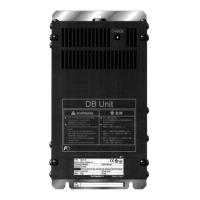10.3 Equations for Selections
10-6
10.3 Equations for Selections
10.3.1 Load torque during constant speed running
[ 1 ] General equation
The frictional force acting on a horizontally moved load must be calculated. Calculation for driving a load along a
straight line with the motor is shown below.
Where the force to move a load linearly at constant speed υ (m/s) is F (N) and the motor speed for driving this is N
M
(r/min), the required motor output torque τ
M
(N·m) is as follows:
(Equation 10.3-1)
where, η
G
is Reduction-gear efficiency.
When the inverter brakes the motor, efficiency works inversely, so the required motor torque should be calculated
as follows:
(Equation 10.3-2)
(60·υ) / (2π·N
M
) in the above equation is an equivalent turning radius corresponding to speed υ (m/s) around the
motor shaft.
The value F (N) in the above equations depends on the load type.
[ 2 ] Obtaining the required force F
■ Moving a load horizontally
A simplified mechanical configuration is assumed as shown in Figure 10.3-1. If the mass of the carrier table is W
0
(kg), the load is W (kg), and the friction coefficient of the ball screw is µ, then the friction force F (N) is expressed as
follows, which is equal to a required force for driving the load:
(Equation 10.3-3)
where, g is the gravity acceleration (≈ 9.8 (m/s
2
)).
Then, the driving torque around the motor shaft is expressed as follows:
)mN(
g)WW(
N
2
60
G
0
M
M
•
••
•
•
•
η
τ
µ+
π
υ
=
(Equation 10.3-4)
Figure 10.3-1 Moving a Load Horizontally

